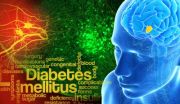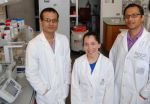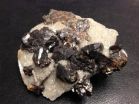(Press-News.org) JUPITER, FL - July 28, 2014 – Research conducted at the Florida campus of The Scripps Research Institute (TSRI) has discovered links between a set of genes known to promote tumor growth and mucoepidermoid carcinoma, an oral cancer that affects the salivary glands. The discovery could help physicians develop new treatments that target the cancer's underlying genetic causes.
The research, recently published online ahead of print by the Proceedings of the National Academy of Sciences, shows that a pair of proteins joined together by a genetic mutation—known as CRTC1/MAML2 (C1/M2)—work with MYC, a protein commonly associated with other cancers, to promote the oral cancer's growth and spread.
"This research provides new insights into the molecular mechanisms of these malignances and points to a new direction for potential therapies," says TSRI biologist Michael Conkright, PhD, who led the study.
The C1/M2 protein is created when the genes encoding CRTC1 and MAML2 mutate into a single gene through a process known as chromosomal translocation. Such mutant "chimera" genes are linked to the formation of several forms of cancer. The team discovered that the C1/M2 protein further activates genetic pathways regulated by MYC, in addition to CREB, to begin a series of cellular changes leading to the development of mucoepidermoid carcinoma.
"The identification of unique interactions between C1/M2 and MYC suggests that drugs capable of disrupting these interactions may have therapeutic potential in the treatment of mucoepidermoid carcinomas, " said Antonio L. Amelio, Ph.D., first author of the study who is now assistant professor with the UNC School of Dentistry and member of the UNC Lineberger Comprehensive Cancer Center.
Researchers have known about the role of C1/M2 and its interactions with another protein, CREB, in the development of mucoepidermoid carcinoma, and physicians screen patients for the presence of the C1/M2 protein when testing for this cancer. These new findings deepen the understanding of C1/M2's role by revealing that it works with a family of cancer-associated genes known as the MYC family to drive the cellular changes necessary for a tumor to develop.
The discovery of these new protein interactions may also reveal insights into the mechanisms behind other cancers that arise due to other genetic mutations involving the CREB and MYC pathways.
INFORMATION:
In addition to Conkright and Amelio, other authors of the study, "CRTC1/MAML2 gain-of-function interactions with MYC create a gene signature predictive of cancers with CREB–MYC involvement," include Mohammad Fallahi of IT Informatics, Franz X. Schaub, Mariam B. Lawani, Adam S. Alperstein, Mark R. Southern, Brandon M. Young, and John L. Cleveland of TSRI, and Min Zhang, Lizi Wu, Maria Zajac-Kaye, and Frederic J. Kaye of Shands Cancer Center, University of Florida (Gainsville).
The research was supported in part by a Howard Temin Pathway to Independence Award in Cancer Research from the National Cancer Institute (NCI) (K99-CA157954), National Institutes of Health/NCI R01 Grant CA100603, a PGA National WCAD Cancer Research Fellowship and Ruth L. Kirschstein National Research Service Award from the National Cancer Institute (F32-CA134121), the Margaret Q. Landerberger Research Foundation, a Swiss National Foundation Postdoctoral Fellowship and monies from the State of Florida to TSRI's Scripps Florida.
Scripps Florida scientists find genetic mutations linked to salivary gland tumors
The findings may point the way to new cancer treatments
2014-07-28
ELSE PRESS RELEASES FROM THIS DATE:
Glucose 'control switch' in the brain key to both types of diabetes
2014-07-28
Researchers at Yale School of Medicine have pinpointed a mechanism in part of the brain that is key to sensing glucose levels in the blood, linking it to both type 1 and type 2 diabetes. The findings are published in the July 28 issue of Proceedings of the National Academies of Sciences.
"We've discovered that the prolyl endopeptidase enzyme — located in a part of the hypothalamus known as the ventromedial nucleus — sets a series of steps in motion that control glucose levels in the blood," said lead author Sabrina Diano, professor in the Departments of Obstetrics, Gynecology ...
Physicists unlock nature of high-temperature superconductivity
2014-07-28
Physicists have identified the "quantum glue" that underlies a promising type of superconductivity -- a crucial step towards the creation of energy superhighways that conduct electricity without current loss.
The research, published online in the Proceedings of the National Academy of Sciences, is a collaboration between theoretical physicists led by Dirk Morr, professor of physics at the University of Illinois at Chicago, and experimentalists led by Seamus J.C. Davis of Cornell University and Brookhaven National Laboratory.
The earliest superconducting materials required ...
Google searches hold key to future market crashes
2014-07-28
A team of researchers from Warwick Business School and Boston University have developed a method to automatically identify topics that people search for on Google before subsequent stock market falls.
Applied to data between 2004 and 2012, the method shows that increases in searches for business and politics preceded falls in the stock market. The study, 'Quantifying the semantics of search behavior before stock market moves,' was published in the Proceedings of the National Academy of Sciences.
The researchers suggest that this method could be applied to help identify ...
Memory relies on astrocytes, the brain's lesser known cells
2014-07-28
VIDEO:
Salk scientists have discovered the link between astrocytes and memory.
Click here for more information.
LA JOLLA—When you're expecting something—like the meal you've ordered at a restaurant—or when something captures your interest, unique electrical rhythms sweep through your brain.
These waves are called gamma oscillations and they reflect a symphony of cells—both excitatory and inhibitory—playing together in an orchestrated way. Though their role has been debated, ...
Scientists discover genetic switch that can prevent peripheral vascular disease in mice
2014-07-28
Millions of people in the United States have a circulatory problem of the legs called peripheral vascular disease. It can be painful and may even require surgery in serious cases. This disease can lead to severe skeletal muscle wasting and, in turn, limb amputation.
At The University of Texas Health Science Center at Houston (UTHealth) Medical School, scientists tested a non-surgical preventative treatment in a mouse model of the disease and it was associated with increased blood circulation. Their proof-of-concept study appears in the journal Cell Reports.
Unlike ...
Mineral magic? Common mineral capable of making and breaking bonds
2014-07-28
TEMPE, Ariz. - Reactions among minerals and organic compounds in hydrothermal environments are critical components of the Earth's deep carbon cycle, they provide energy for the deep biosphere, and may have implications for the origins of life. However, very little is known about how minerals influence organic reactions. A team of researchers from Arizona State University have demonstrated how a common mineral acts as a catalysts for specific hydrothermal organic reactions – negating the need for toxic solvents or expensive reagents.
At the heart of organic chemistry, ...
Forced mutations doom HIV
2014-07-28
CAMBRIDGE, MA -- Fifteen years ago, MIT professor John Essigmann and colleagues from the University of Washington had a novel idea for an HIV drug. They thought if they could induce the virus to mutate uncontrollably, they could force it to weaken and eventually die out — a strategy that our immune system uses against many viruses.
The researchers developed such a drug, which caused HIV to mutate at an enhanced rate, as expected. But it did not eliminate the virus from patients in a small clinical trial reported in 2011. In a new study, however, Essigmann and colleagues ...
Tennessee Surgical Quality Collaborative saves 533 lives and $75 million in 3 years
2014-07-28
NEW YORK (July 28, 2:45 pm [ET]): Ten hospitals in the Tennessee Surgical Quality Collaborative (TSQC) have reduced surgical complications by 19.7 percent since 2009, resulting in at least 533 lives saved and $75.2 million in reduced costs, according to new results presented today at the American College of Surgeons National Surgical Quality Improvement Program (ACS NSQIP®) National Conference in New York City.
The hospital collaborative was formed in 2008 as a partnership of the Tennessee Chapter of the American College of Surgeons and the Tennessee Hospital Association's ...
Stimulation of brain region restores consciousness to animals under general anesthesia
2014-07-28
Stimulating one of two dopamine-producing regions in the brain was able to arouse animals receiving general anesthesia with either isoflurane or propofol. In the August issue of Anesthesiology, investigators from Massachusetts General Hospital (MGH) report that rats anesthetized with continuous doses of either agent would move, raise their heads and even stand up in response to electrical stimulation delivered to the ventral tegmental area (VTA). Stimulation of the other major dopamine-releasing area, the substantia nigra, did not induce the animals to wake up.
"Dopamine ...
Study suggests disruptive effects of anesthesia on brain cell connections are temporary
2014-07-28
A study of juvenile rat brain cells suggests that the effects of a commonly used anesthetic drug on the connections between brain cells are temporary.
The study, published in this week's issue of the journal PLOS ONE, was conducted by biologists at the University of California, San Diego and Weill Cornell Medical College in New York in response to concerns, arising from multiple studies on humans over the past decade, that exposing children to general anesthetics may increase their susceptibility to long-term cognitive and behavioral deficits, such as learning disabilities.
An ...
LAST 30 PRESS RELEASES:
Existing drugs studied in patients with rare immune diseases
Loma Linda University study reveals alarming rates of pediatric injuries from mechanical bull riding
Excessive pregnancy weight gain and substantial postpartum weight retention common in military health care beneficiaries
Odor-causing bacteria in armpits targeted using bacteriophage-derived lysin
Women’s heart disease is underdiagnosed, but new machine learning models can help solve this problem
Extracting high-purity gold from electrical and electronic waste
Tropical fish are invading Australian ocean water
No bull: How creating less-gassy cows could help fight climate change
ECU researchers call for enhanced research into common post-stroke condition
SharpeRatio@k: novel metric for evaluation of risk-return tradeoff in off-policy evaluation
$1.8M NIH grant will help researchers follow a virus on its path to the nucleus
Follow-up 50 years on finds landmark steroid study remains safe
Active military service may heighten women’s risk of having low birthweight babies
Significant global variation in national COVID-19 treatment guidelines
Cost increasingly important motive for quitting smoking for 1 in 4 adults in England
Is there an association between HPV vaccination and anti-NMDA receptor encephalitis?
Blood-based multi-omics guided detection of a precancerous pancreatic tumor
Eye-opener: Pupils enlarge when people focus on tasks
Current Nanomaterials and Current Analytical Chemistry have been indexed in Ei Compendex
International balance of power determined by Chinese control over emerging technologies, study shows
New writing therapy helps late-stage cancer patients face biggest fears
National Jewish Health researchers identify connection between air pollutants and allergic diseases
In the United States, the election of progressive prosecutors led to higher relative rates of property and overall crime, but not to higher relative rates of violent crime
European Court of Human Rights is “backsliding” on legal protections for asylum seekers, study says
Being treated by a female physician associated with lower risk for death
Treatment from female doctors leads to lower mortality and hospital readmission rates
Historically redlined areas see more modern-day gun violence
Bonobos aren’t as peace-loving as we thought
Abdominal obesity might predict risk of fecal incontinence
Smartphone swabs provide convenient toxicology testing
[Press-News.org] Scripps Florida scientists find genetic mutations linked to salivary gland tumorsThe findings may point the way to new cancer treatments





